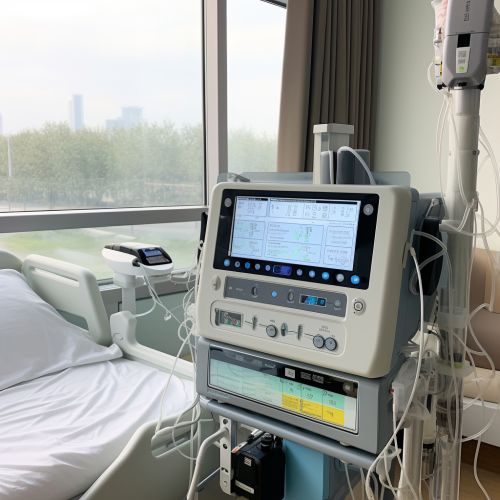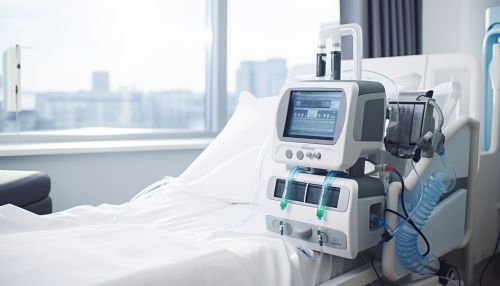Mechanical ventilation
Introduction
Mechanical ventilation is a method to mechanically assist or replace spontaneous breathing. This may involve a machine called a ventilator, or the breathing may be assisted manually by a suitably qualified professional, such as an anesthesiologist, respiratory therapist, or paramedic, using a bag valve mask device.
History
The history of mechanical ventilation begins with various forms of respiratory therapy in which a variety of methods were used to mechanically assist respiration. In the early 20th century, negative pressure ventilation was the main method of mechanical ventilation. This involved placing the patient inside a large iron lung, which would then be sealed except for the patient's head and neck. The iron lung would then create a negative pressure environment, which would cause the patient's chest and abdomen to expand, drawing air into the lungs. This method was largely replaced by positive pressure ventilation in the mid-20th century due to its greater efficacy and ease of use.
Types of Mechanical Ventilation
There are two main types of mechanical ventilation: invasive and non-invasive.


Invasive Mechanical Ventilation
Invasive mechanical ventilation involves the use of a machine to deliver breaths directly into the lungs through a tube inserted into the patient's airway. This is typically done through a procedure known as intubation, in which a tube is inserted through the mouth or nose and into the trachea. This form of ventilation is often used in critical care settings, such as in an intensive care unit (ICU), during surgery, or when a patient is unable to breathe on their own due to a medical condition or injury.
Non-Invasive Mechanical Ventilation
Non-invasive mechanical ventilation, on the other hand, does not involve inserting a tube into the patient's airway. Instead, positive pressure is applied to the patient's airway through a mask or similar device. This form of ventilation is often used for patients who are able to breathe on their own but need some assistance to maintain adequate oxygenation and ventilation. Examples of non-invasive mechanical ventilation include continuous positive airway pressure (CPAP) and bilevel positive airway pressure (BiPAP).
Mechanisms of Mechanical Ventilation
Mechanical ventilation works by creating a pressure gradient in the lungs, which allows air to flow into the lungs. There are two main types of mechanical ventilation based on the mechanism of action: positive pressure ventilation and negative pressure ventilation.
Positive Pressure Ventilation
In positive pressure ventilation, air is pushed into the lungs when the pressure in the ventilator is higher than the pressure in the patient's lungs. This is the most common type of mechanical ventilation used in modern medicine. It can be delivered either invasively or non-invasively, as discussed above.
Negative Pressure Ventilation
Negative pressure ventilation, on the other hand, works by creating a lower pressure outside the lungs, causing them to expand and draw in air. This type of ventilation is less commonly used today, but was the main form of mechanical ventilation prior to the development of positive pressure ventilation.
Indications for Mechanical Ventilation
Mechanical ventilation is indicated in any situation where a patient is unable to maintain adequate oxygenation and ventilation on their own. This can occur due to a wide range of conditions, including respiratory failure, neurological disorders, and severe injuries. Some specific indications for mechanical ventilation include:
- Acute respiratory distress syndrome (ARDS) - Chronic obstructive pulmonary disease (COPD) - Pneumonia - Asthma - Neuromuscular diseases, such as amyotrophic lateral sclerosis (ALS) - Trauma or injury to the chest or lungs - Overdose or poisoning - Post-operative care, particularly after surgeries involving the chest or abdomen
Complications of Mechanical Ventilation
While mechanical ventilation can be life-saving, it is not without risks. Complications can occur due to the process of intubation, the pressure applied to the lungs, or the underlying condition that necessitated ventilation. Some potential complications include:
- Ventilator-associated pneumonia (VAP) - Barotrauma, or injury to the lungs caused by high pressure - Oxygen toxicity, which can occur when high levels of oxygen are delivered for extended periods - Stress ulcers - Deep vein thrombosis (DVT) - Psychological stress and anxiety
Future of Mechanical Ventilation
The field of mechanical ventilation is constantly evolving, with new technologies and techniques being developed to improve patient outcomes. Some areas of current research include the use of computer algorithms to optimize ventilator settings, the development of new modes of ventilation, and the use of non-invasive ventilation in more patient populations.
See Also
- Respiratory therapy - Intensive care medicine - Pulmonology - Anesthesiology
